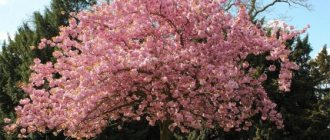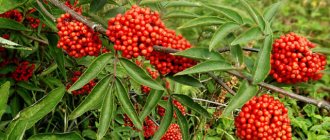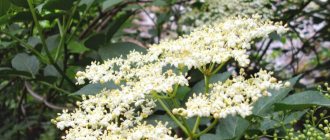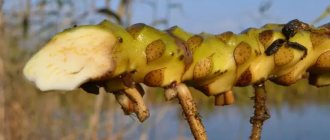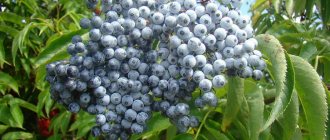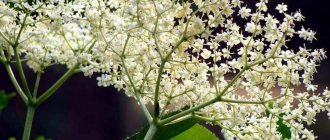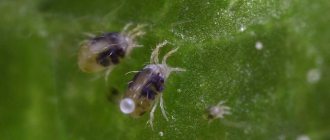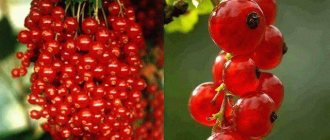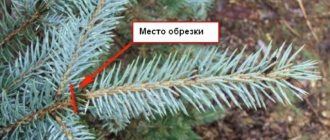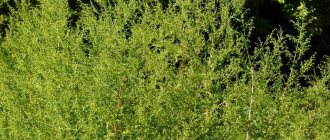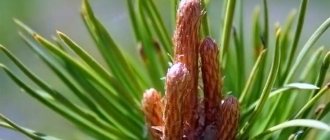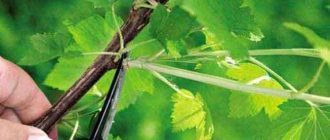Loading…
Loading…
From a distance, lush white clusters or packed scarlet clusters of red elderberry can be mistaken for viburnum. But coming closer and inhaling the not very pleasant aroma of leaves and flowers, it becomes clear that this is a completely different plant. However, it is still often planted in gardens, and not for culinary purposes. Red berries are not tasty and even dangerous due to their high content of toxic toxins. But the flowering shrub looks spectacular and has long been recognized in folk medicine due to its healing properties.
Name
Photo:
The specific epithet in the scientific name of the plant (Latin racemosa) can be translated as “racemose”, “bunch-like”, “branched” (from racemus - “grape brush”, “bunch of grapes”).
There are several Russian names for the species in the literature:
- elder racemose, elderberry racemosa (in the list of Russian plants this name is in first place in the 3rd edition of the Great Soviet Encyclopedia);
- red elderberry (in first place in the Great Russian Encyclopedia);
- common elderberry.
Use for foot problems
An alcohol tincture based on this plant is an excellent remedy for problems associated with the feet. For example, with a heel spur. Conveniently, a similar tincture of elderberry red plumosa aurea can be stored for quite a long time – 3 years.
To prepare it, you will need to fill three quarters of a liter jar with fruits, and then fill the container to the top with alcohol. It is important to close the jar as best as possible. It should infuse for a month in some warm place. Once the product is ready for use, you will need to rub it in or use it as a compress.
Spreading
Red elderberry is widespread in Eurasia and North America.
In Russia, the plant is distributed from the western borders to the Pacific Ocean (also found in the Ciscaucasia, Western Siberia, Eastern Siberia, and the Kuril Islands).
At the same time, Siberian elderberry is more common in Siberia, which is considered by some authors as a subspecies of red elderberry (Sambucus racemosa subsp. sibirica (Nakai) H.Hara), by others - as a separate species Sambucus sibirica Nakai.
In Europe, the plant is found everywhere in the southern (Albania, Bulgaria, Greece, Spain, Italy, Romania, France, countries of the former Yugoslavia), central (Austria, Belgium, Hungary, Germany, the Netherlands, Poland, Slovakia, Czech Republic, Switzerland) and eastern parts (Belarus, European part of Russia).
The Eurasian part of the range also includes northern China, Korea and Japan (the islands of Hokkaido, Honshu, Kyushu and Shikoku).
The American part of the range includes Canada and the United States (including Alaska); The downy elderberry growing here is considered by some authors as a subspecies of red elderberry (Sambucus racemosa subsp. pubens (Michx.) House), by others - as a separate species Sambucus pubens Michx.
The plant is native only to the mountainous regions of Europe. In the territory of the former USSR, such areas include Western Ukraine, where the plant is found in the undergrowth of coniferous and mixed forests.
For the European part of Russia, red elderberry is an adventitious plant. Since ancient times, it has been grown for decorative purposes in gardens and parks, and the plants were often naturalized.
Within populated areas, the plant grows in vacant lots, ruins of buildings, and often on the roofs of houses. In nature, red elderberry is most often found in ravines, on the edges of deciduous and mixed forests.
general characteristics
Elderberry is a plant with a trunk up to 7 meters long and up to 30 centimeters wide. Elderberry grows up to 60 years. The crown of the plant is rounded, the leaves are large, up to 30 centimeters long. The flowers are yellow-white, with a pronounced fragrant smell, collected in bunches. Elderberry blooms from May to June, berries appear in August-September. Black elderberry berries are round berries 5-7 millimeters in diameter, collected in clusters.
Content:
- general characteristics
- Chemical composition and calorie content
- Beneficial features
- Harm and contraindications
- Collection and storage
- Application in medicine
- Traditional medicine recipes
- Use in cooking
Wild elderberry grows in nature among other shrubs on the edges of forests, in parks, along the banks of rivers and reservoirs. Most often, the plant is found in Belarus, Ukraine, the Caucasus, the Baltic states and southeast Russia. It is also found in North and South America, Algeria, Tunisia and the Azores.
Elderberry is one of the unpretentious shrubs that grows well in both shade and sunny places. It is important to distinguish black elderberry from red elderberry. Black elderberry is a medicinal plant, and red elderberry is one of the plants that is poisonous and dangerous to humans.
Dried inflorescences and fruits of black elderberry are used as medicinal raw materials. Roots, bark and branches are less commonly used as medicinal raw materials.
Botanical description
Red elderberry is a shrub with a large number of straight stems coming from the base (in rare cases, a tree), the height of which varies from one and a half to three to five meters.
The bark may be smooth or flaky to the touch. On the surface of the bark there are lentils (white tubercles), through which the plant breathes.
In spring, large, oval-ovoid buds appear. The leaves are opposite, imparipinnate, and consist of five to seven leaflets.
The leaves are ovate or elongated-lanceolate, have a serrate-toothed edge, the length varies from 5 to 10 cm.
The leaves have a specific characteristic smell. The anthocyanin content in young leaves is quite high, so they have a dark red or purple-black hue.
The flowers of the shrub are small, with a strong unpleasant aroma. The plant has flowers of both sexes. The perianth is double, five-membered.
The corolla is wheel-shaped, light yellow or greenish-yellow, closer to golden in color. The flower has five stamens.
Elderberry begins to bloom in the second half of May, or at the beginning of June, at the same time the leaves bloom, this period lasts about half a month.
The pollen is yellow in color, the pollen grains are tricolate-oroform, ellipsoidal in shape.
The fruit is a drupe, bright scarlet in color. Ripening occurs in the second half of July or early August. The berries have a characteristic, unpleasant taste and aroma, but when ripe it cannot be called poisonous.
The most popular variety, which is widely used in the landscape design of city parks and squares, and also grows in gardeners' garden plots, is the Sutherland Gold variety.
This variety has beautiful and dense golden yellow foliage.
Type of black elderberry: varieties for the Moscow region, care and cultivation (with photo)
The most popular and recognizable species is the black elderberry. Look at the photo for its varieties - all of them, with proper care, can perform decorative tasks:
To better understand what black elderberry looks like, read the description below. This is a very productive shrub or small (no taller than 10 meters) tree. Loves sunlight, but also does well in the shade. Adult specimens have branched stems, gray bark, rather large (10-30 cm) odd-pinnate leaves, consisting of 3-9 separate segments. Planting black elderberry and caring for it in the future are simple.
The flowers are collected in wide shield-shaped inflorescences up to 25 cm in diameter: snow-white or with a slightly yellowish tint, less often pale pink. To find out how elderberry blooms, you will have to wait until spring and summer. During flowering, it emits a characteristic aroma that attracts honey harvesting insects. Black-purple, glossy fruits with 2-3 seeds and scarlet pulp ripen closer to September. They contain persistent pigmenting substances.
The berries of the black elderberry bush have a sweet and sour taste; the fruits, as well as the inflorescences, contain many biologically active components. Therefore, growing black elderberry is very important for alternative medicine.
Medicinal infusions with valuable properties are prepared from plant raw materials:
- anti-inflammatory;
- antiseptic;
- sedatives;
- laxatives;
- antipyretic;
- bile-, diuretic.
The raw materials are also used for external use for hemorrhoids, burns, diaper rash, ulcers, and wounds. The fruits are used to make delicious jam, marmalade, compotes, and make liqueur. There are contraindications for use (pregnancy, Crohn's syndrome, colitis, etc.). Leaves and bark are toxic to humans.
Growing and caring for black elderberry has no distinctive features; it is carried out according to the general principles described in detail in the article. Black elderberry is also propagated using standard methods - each gardener chooses the most suitable technique for himself.
The following will list the most popular varieties of black elderberry; this species is very popular with gardeners and is actively used by landscape designers:
Aurea. A lime-colored crown grows.
Luteovariegata. The leaves are initially bright yellow in color, later becoming white-yellow.
Aureo-variegata. The variety is characterized by golden-variegated foliage.
Albomarginata. The leaves are spotted, edged with a white stripe.
Argentea. There are green blotches on the white leaves.
Guincho Purple. In spring the crown is green, in summer it is bright purple. The flowers are pink and fade a little over time.
Black Beauty. Purple leaves, pink inflorescences with a pleasant citrus aroma will conquer every person. The purple-black berries are edible.
Rotundifolia. Slow growing bush with wide leaves. The inflorescences are delicate, not abundant.
Sampo. A valuable variety for industrial production with average cluster parameters, but large, appetizing fruits.
Due to their relative immunity to frost, most of the described varieties of black elderberry are also suitable for the Moscow region with its strict climate.
Before using parts of a particular variety for treatment or food, you need to consult with an experienced herbalist or herbalist. This is necessary in order not to confuse edible species with poisonous ones, and not to cause harm to health with incorrect dosages.
Chemical composition
Little is known about the chemical composition of red elderberry, since no one has undertaken a thorough study of this issue.
It is known that it contains a sufficient amount of vitamin C, as well as tannin, sugars (glucose, fructose), essential oils, organic acids, tannins, mineral salts and resins.
Unripe parts of the plant and fruits contain the poisonous glycoside sambunigrin, which breaks down into benzaldehyde and hydrocyanic acid.
Specifics of black elderberry
The plant has a wide range of uses.
Pharmacological use
- Flowers, due to the content of essential oils, rutin and mucus, which can envelop the mucous membranes of the nasopharynx, as well as the presence of tanning substances, are widely used as an antiviral and antiphlogistic agent.
- The leaves, despite the presence of nerve paralytic elements in small quantities, are used as a remedy to counteract inflammatory processes.
- Fruits are a real “storehouse” of vitamins, sugars and organic acids. They contain carotene and rutin, which increase hemoglobin levels and improve the elasticity of small vessels. Natural highly effective laxative.
- Roots and bark. It is a diuretic and expectorant. The bark is a source of vitamin B4, which has atherosclerotic, membrane-protective and sedative effects, normalizes fat metabolism, and helps to lose weight.
Black elderberry bark is a source of vitamin B4
In nutrition
Elderberry water is made from elderberry flowers - a flavoring agent for liqueurs and fortified tinctures. The fruits are used as food coloring in creams, sweets, and wines. Used as a dietary supplement with almond flavor. A seasoning that can replace pepper.
Berries are consumed both fresh and processed. The scope of their application is extensive. This includes confectionery, jellies, winemaking, even vinegar making. Jam is made from the petals. Young leaves are good in salads.
In landscape design
An excellent option for landscaping, creating garden compositions and as a free-standing component of a garden composition. Thanks to its beautiful shape, it looks great in the center of smaller plants. It is bred to shade gazebos, dilute hedges and decorate the coastal zone of ponds.
In cosmetology
Cosmetics with elderberry are known as anti-aging, tonic, and:
- has an antioxidant effect;
- improves skin immunity;
- relieves inflammation, swelling;
- calms;
- tones;
- gives elasticity.
Poisonous or not?
Are red elderberries edible? When ripe, the berries of this plant are not poisonous, but their taste is unpleasant, so it is unlikely that anyone would want to eat them.
But elderberries become safe only after they have been heat treated. It is strictly forbidden to consume these fruits raw - otherwise you can get severe poisoning.
Unripe fruits and other parts of this plant contain the glycoside sambunigrin, which is poisonous and breaks down into components such as hydrocyanic acid and benzaldehyde.
Ripe elderberry contains mineral salts, as well as tannins, acids, fructose and glucose, tannin, and vitamin C.
Application in cosmetology
The external use of red elderberry has virtually no contraindications and is used in home cosmetics.
The following phytocosmetics can be made from this plant:
- Lotion for problematic sensitive skin. For him 5-6 tbsp. l. dry inflorescences are poured into a glass of boiling water and allowed to brew for 15 minutes. Then filter the infusion and wipe your face with it twice a day. Within two weeks, the skin condition improves.
- Whitening tonic. Pour 3 tbsp with two glasses of boiling water. l. fresh fruits and cook over low heat for 10 minutes. Then the broth is allowed to cool and filtered. Wipe the skin of the face twice a day.
- Rejuvenating mask. Dry fruits and leaves of red elderberry are crushed (in a meat grinder or coffee grinder) and mixed with sour cream in a ratio of 1 to 1. The mask is applied to the facial skin for 20 minutes and then washed off.
The properties of red elderberry do not allow it to be used in its pure form as a cosmetic product. But if processed properly, it is quite possible. For example, to create a bleaching agent, you will need to pour 2 cups of boiling water into 3 tbsp. l. dried flowers and let them brew.
For a refreshing effect, you can make a mask of elderflower flowers. They are poured with boiling water until a paste forms. This paste is applied in an even layer onto gauze and then left on the face for 20 minutes. Next, the product is washed off with warm water.
Differences between black and red
There are more than 20 species of elderberry in nature, most of them are credited with medicinal properties, but at the same time, many of its species are famous for their aesthetic merits, due to which they are widely used for decorative purposes in garden plots.
Within our country there are 9 species, which are shrubs, trees or herbaceous plants. Red, black and Canadian elderberry species are widely used in our country.
A significant, but far from the only, difference between black and red elderberry species is the color of their fruits. Other differences between these types are as follows:
The fruits of the black elderberry can be eaten as they are considered edible. Red elderberry has a characteristically unpleasant fruit taste, so its fruits are not recommended for consumption.
The height of the red elderberry plant is significantly greater than that of the black elderberry.
Plants of these two species differ in the structure and shade of the leaves. The smell of these two species is also different.
The taste of red elderberry is not the only reason for its inedibility. Red elderberry is poisonous. Unripe parts of the plant and fruits are toxic; they contain a toxic substance – sambunigrin.
Red elderberry poisoning
Not everyone is aware that the fruits of the bush are toxic. When children eat red elderberry berries, it is necessary to call an ambulance, since the small organism is unable to cope with poisoning on its own.
Signs of poisoning: dizziness, spatial disorientation, nausea and vomiting, bitterness in the throat, sore throat, abdominal pain, diarrhea, increased salivation, increased heart rate. An adult who has been poisoned can be helped by the following measures: flushing the stomach with a light solution of potassium permanganate, inducing vomiting, laxatives and charcoal.
Red elderberry is a wonderful ornamental plant, widely used in folk medicine. Whether it is poisonous or not depends on the content of hydrocyanic acid in it, the level of which decreases during ripening.
Beneficial features
The fruits and other parts of the red elderberry plant are known for their beneficial properties.
However, this plant is not officially used for medical purposes - its composition and effect on the human body have not been sufficiently studied.
In folk medicine
Medicinal properties are popularly attributed to the flowers, fruits, leaves and roots of the bush.
The plant has antispasmodic, antipyretic, anesthetic effects.
Different parts of elderberry may help treat symptoms of the following diseases:
- Bronchitis, severe cough. An infusion from the bark of the plant can relieve phlegm in the lungs.
- Cold, fever. An infusion of dry berries has a diaphoretic effect and reduces elevated body temperature.
- Hormonal imbalance, menopause. Taking orally, drops, tinctures from elder flowers, in alcohol, normalizes the general condition of the female body.
- Migraine. For this disease, a decoction of red elderberry flowers is used.
Decoctions and tinctures from the fruits, leaves and other parts of elderberry also help with kidney and liver diseases, skin rashes, allergies, diseases of the cardiovascular system, arthritis, psoriasis, and various inflammatory processes.
For other purposes
In addition to the decorative use of red elderberry, in gardening it is also used to repel pests and rodents.
To do this, stems and leaves of red elderberry are laid out indoors or near cultivated plants. Their smell can repel some types of pests.
In home gardens, gardeners use elderberry as a natural cleanser. Its fruits, despite the fact that they do not form foam, cope well with dirty hands and dirt on household surfaces.
In European countries, green paint is made from red elderberry, the seeds are processed into oil, which is later used for technical purposes, and alcohol is made from the fruits.
Traditional medicine recipes
Black elderberry tincture for the treatment of diabetes
- 1 tablespoon dried berries;
- 200 grams of boiling water.
Pour boiling water over the berries and leave for 20 minutes. Take 50 ml after meals.
Black elderberry tincture as a laxative
- 1 teaspoon dried fruits;
- 200 grams of boiling water.
Pour boiling water over the berries and leave for 15-20 minutes. Take 2-3 times.
Tincture of black elderberry fruits for the treatment of colds
- 15 grams of dried fruits;
- 200 grams of boiling water.
Pour boiling water over the berries and leave for 30 minutes. Take ¼ cup with honey 15 minutes before meals.
Black elderberry tincture for the treatment of constipation
- 10 grams of dried fruits;
- 200 grams of boiled water.
Pour chilled boiled water over the berries, leave for 2 hours and strain. Take 200 ml once daily.
Decoction of black elderberry leaves
- 1 tablespoon of leaves;
- 200 grams of boiled water.
Pour water over the leaves and boil for 5 minutes. Then leave until cool. Take a tablespoon three times a day for diabetes, gout, rheumatism and edema.
Elderberry juice in the treatment of tumors
- fresh berries;
- sugar.
Fresh black berries are placed in a three-liter jar 1.5-2 cm thick, sprinkled with sugar, then another 1.5-2 cm layer of berries and so on until completely filled. Leave for up to 30 days. Drink the resulting juice one tablespoon after meals three times a day. 15 minutes before meals, drink 150 ml of distilled water.
Alcohol-based elderberry juice for the treatment of mastopathy
- berries;
- 250 ml medical alcohol.
Squeeze 250 ml of juice from the berries of the plant and add 250 ml of alcohol to it. Drink the resulting solution with milk three times a day, starting with one drop. Reach up to forty drops, then reduce daily to one drop.
Contraindications
Flowers, fruits, and leaves of red elderberry are toxic, so they should be used for medicinal purposes with extreme caution.
For medicinal preparations, only ripe fruits, mature shoots and leaves are used, otherwise the content of hydrocyanic acid can only harm the body.
You should also not treat children under twelve years of age, pregnant or lactating women with folk recipes based on elderberry.
Features of elderberry care
At the beginning of spring, when the sun begins to heat up during the day and frosts still persist at night, the bark of large shoots may crack. To avoid damage, the shoots and trunk are covered with a layer of lime.
Photos of unusual flower beds can be seen here
At the beginning of March, sanitary pruning is carried out for fruit species and, if necessary, formative pruning for decorative deciduous forms. Remove dead, damaged or diseased shoots.
Dense bushes are thinned out, side and unwanted branches that develop at the wrong angle are removed. To avoid infection, the cutting areas of large shoots are lubricated with garden varnish.
The crop tolerates the climatic conditions of the middle zone well, but in severe frosts the delicate elderberry varieties “Black Lace” and “Black Beauty” can freeze. In this case, the bushes are pruned, leaving only 20-30 cm to the soil level. Over the course of a season, the plant forms new dense shoots with decorative foliage. Anti-aging pruning is also carried out every 3 years.
After any type of pruning, when the buds have not yet blossomed, the elderberry is treated with a solution of Bordeaux mixture or other drugs with similar effects to prevent diseases and destroy pests. Repeated treatment is carried out in the fall after leaf fall. Diseased fallen leaves are burned.
During the period of flowering, active growing season and fruit formation, the crop needs fertilizing and watering. Numerous root shoots of shrubs must be regularly removed at the very beginning of growth.
At the end of autumn, before the onset of frost, the tree trunk area is insulated with fallen leaves or compost. An excellent insulation material is fallen snow, which is thrown onto the plantings.
Planting and care
In gardens, parks, and summer cottages, elderberry bushes are planted individually - shrubs with bright leaves look very impressive against the background of grass.
It goes well with other shrubs and is often used to decorate flower beds. This shrub is also used in the process of creating hedges.
It has a dense crown, which allows you to reliably protect the area from prying eyes. This plant is also often planted on the banks of artificial reservoirs.
Those seedlings that are one or two years old take root best. Bushes with bare roots are planted in the ground in November or spring. Plants are planted in containers throughout the season.
This plant does not require care. If you want to achieve abundant fruiting and beautiful leaf color, plant the bushes in sunny, wind-protected places.
This crop prefers fertile soil rich in nitrogen compounds and humus, in which water does not stagnate.
It can adapt to other substrates that have a poorer composition, but in this case the elderberry will bloom less profusely.
If the soil is acidic, it should be limed a couple of years before planting the bushes.
Reproduction
When growing elderberries, propagation is possible by cuttings, as well as by layering, seeds, or dividing the bush. The most effective method of propagating elderberry is by layering.
In this case, the probability of obtaining seedlings from the cuttings is almost one hundred percent. Such reproduction is carried out as follows.
Young side shoots of the plant, which have not yet become woody, are tilted towards the ground, after which they are placed in pre-dug grooves with a compost layer along the length of the shoot.
To prevent the shoots from straightening out, they are secured with compost staples, after which they are covered with soil on top. The top of each branch is left uncovered.
Red elderberry is often propagated by cuttings.
Green cuttings about 15 centimeters long with a pair of internodes on each of them are cut off and all leaves are removed from them except the upper leaf petiole with a pair of leaflets, after which they are planted in a pot filled with a sand-peat mixture.
The planted cuttings are watered, then covered with a transparent bag on top to create greenhouse conditions.
During rooting, pots with plants are placed in a place where there is no direct sunlight. An improvised greenhouse should be periodically ventilated and the soil watered.
Once the plant shows signs of growth, remove the plastic bag. Young bushes are planted in open ground in mid-autumn.
Care
In the spring, the branches of the plant are covered with a layer of lime, pruned and preventively treated with Bordeaux mixture against pests and diseases.
After flowering, elderberries are sprayed against powdery mildew. The berries are harvested in August.
In September, the bush is sanitized by digging up the soil around it. Fertilizers are applied. Underground irrigation is carried out. When snow falls, it is thrown under the bush to protect the plant from winter frosts.
How to propagate elderberry by cuttings and other methods
Elderberry is bred by cuttings, sowing seeds, dividing bushes or forming layering. Propagation of elderberry by cuttings is a convenient and most well-known method. Both lignified and young cuttings are used. They must contain at least 3 internodes and several upper leaves. The material is harvested in June-July.
Cuttings (10-12 cm) cut from an adult plant are placed in a sand-peat mixture and covered with a jar on top. It is advisable to treat the part of the stem that will come into contact with the ground with a root former before planting - this composition will speed up the rooting process significantly. Regular watering is required. In autumn, seedlings are sent to open ground.
Seeds are collected around the end of October, sowing is carried out immediately or in the spring. If the procedure is planned for the spring, then the seeds must be prepared properly:
- they are pre-soaked for 3-6 days;
- water is changed daily;
- then the seeds are mixed with wet sand, placed in an airtight container, and placed in the refrigerator for 50-60 days.
Sow seeds to a depth of 2-3 cm, maintaining the distance between rows. In the first summer season, seedlings grow noticeably (up to 0.5-0.6 m); at the age of 1 year they are transplanted to a permanent “habitat”. Autumn sowing does not require pre-treatment of seeds.
The key features of this method of planting and caring for elderberries are shown in the photo - look through them to make sure you do all the steps correctly:
How to propagate elderberry to achieve almost 100% survival rate of the young plant? The best option is the formation of layering, which is added dropwise from an adult bush in the fall or spring. A branch of a 2-3 year old plant is bent and placed in a trench dug the day before. Compost is added to the bottom of the groove. The shoots are securely secured with a bracket made of metal, dug in well, leaving the top of the branch above the ground (it is cut off by 10 cm after planting). The plant needs frequent watering, especially until it takes root.
Dividing the root system is done in the fall. A large, perennial bush is dug up and divided into equal sections. To do this you will need a saw or a sharp ax. Places of cuts/cuts are coated with ash and immediately planted in prepared trenches or containers (if spring planting is planned).
Collection and procurement of raw materials
Red elderberry flowers are harvested during their full opening. This usually occurs in May - June (depending on the growing region). The bark is removed from a young bush in mid-spring (April), when sap flow has already begun. The berries are harvested only when they are fully ripe. The raw materials are dried in a dry, ventilated room, out of direct sunlight. It is then placed in a clean glass container and sealed tightly. Store in a dark, dry room at a temperature of +5…+25°C.
Diseases and pests
Black elderberry: description, planting and care
Just like the black elderberry, the red variety is resistant to diseases; there are no specific pathologies for it. As for pests, the only possible infection here is aphids, which can take a liking to the top of the plant. This phenomenon can be prevented. To do this, in the spring the bushes are treated with karbofos or some herbal remedies (for example, garlic or tar solution).
Pests on elderberry
Anti-cancer applications
Finding out why red elderberry is useful, many do not even suspect that it can be used to fight cancerous tumors. To do this, place the ripe berries in a jar and sprinkle each layer with sugar.
You need to drink the tincture three times a day after meals, a tablespoon. At the same time, before eating, you need to remember to pour yourself a glass of water. After each use, the product should be hidden in the refrigerator. However, if you have diabetes or chronic problems with the digestive system, it is better to refrain from such therapy.
